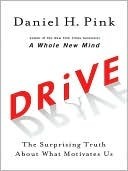More on this book
Community
Kindle Notes & Highlights
Started reading
November 30, 2023
To answer the question, Harlow offered a novel theory—what amounted to a third drive: “The performance of the task,” he said, “provided intrinsic reward.” The monkeys solved the puzzles simply because they found it gratifying to solve puzzles. They enjoyed it. The joy of the task was its own reward.
In an echo of what Harlow discovered two decades earlier, Deci revealed that human motivation seemed to operate by laws that ran counter to what most scientists and citizens believed. From the office to the playing field, we knew what got people going. Rewards—especially cold, hard cash—intensified interest and enhanced performance. What Deci found, and then confirmed in two additional studies he conducted shortly thereafter, was almost the opposite. “When money is used as an external reward for some activity, the subjects lose intrinsic interest for the activity,” he wrote.5 Rewards can
...more
W. Edwards Deming, whose work was embraced in Japan with the same ferocity with which it was ignored in the U.S., argued that the route to quality and continual improvement was intrinsic motivation rather than extrinsic motivators like bonuses, incentive plans, and forced rankings.
Go back to that encyclopedic showdown between Microsoft and Wikipedia. The assumptions at the heart of Motivation 2.0 suggest that such a result shouldn’t even be possible. Wikipedia’s triumph seems to defy the laws of behavioral physics.
In other words, companies that typically rely on external rewards to manage their employees run some of their most important systems with products created by nonemployees who don’t seem to need such rewards.
but they found “that enjoyment-based intrinsic motivation, namely how creative a person feels when working on the project, is the strongest and most pervasive driver.”
Dubbed an L3C, this entity is a corporation—but not as we typically think of it. As one report explained, an L3C “operate[s] like a for-profit business generating at least modest profits, but its primary aim [is] to offer significant social benefits.” Three other U.S. states have followed Vermont’s lead.
And three U.S. entrepreneurs have invented the “B Corporation,” a designation that requires companies to amend their bylaws so that the incentives favor long-term value and social impact instead of short-term economic gain.5
In short, we are irrational—and predictably so, says economist Dan Ariely, author of Predictably Irrational, a book that offers an entertaining and engaging overview of behavioral economics.
The best use of money as a motivator is to pay people enough to take the issue of money off the table.
Twain extracts a key motivational principle, namely “that Work consists of whatever a body is OBLIGED to do, and that Play consists of whatever a body is not obliged to do.” He goes on to write:
Only contingent rewards—if you do this, then you’ll get that—had the negative effect. Why? “If-then” rewards require people to forfeit some of their autonomy. Like the gentlemen driving carriages for money instead of fun, they’re no longer fully controlling their lives.
“People use rewards expecting to gain the benefit of increasing another person’s motivation and behavior, but in so doing, they often incur the unintentional and hidden cost of undermining that person’s intrinsic motivation toward the activity.”
These economists’ conclusion: “We find that financial incentives . . . can result in a negative impact on overall performance.”
The problem with making an extrinsic reward the only destination that matters is that some people will choose the quickest route there, even if it means taking the low road.
In fact, the business school professors suggest they should come with their own warning label: “Goals may cause systematic problems for organizations due to narrowed focus, unethical behavior, increased risk taking, decreased cooperation, and decreased intrinsic motivation. Use care when applying goals in your organization.”
CARROTS AND STICKS: The Seven Deadly Flaws 1. They can extinguish intrinsic motivation. 2. They can diminish performance. 3. They can crush creativity. 4. They can crowd out good behavior. 5. They can encourage cheating, shortcuts, and unethical behavior. 6. They can become addictive. 7. They can foster short-term thinking. CHAPTER 2 A . . . and the Special Circumstances When They Do Carrots and sticks aren’t all bad.
Ultimately, Type I behavior depends on three nutrients: autonomy, mastery, and purpose. Type I behavior is self-directed. It is devoted to becoming better and better at something that matters. And it connects that quest for excellence to a larger purpose.
“The ultimate freedom for creative groups is the freedom to experiment with new ideas. Some skeptics insist that innovation is expensive. In the long run, innovation is cheap. Mediocrity is expensive—and autonomy can be the antidote.” TOM KELLEY General Manager, IDEO
Type I behavior emerges when people have autonomy over the four T’s: their task, their time, their technique, and their team.
In the 1930s and 1940s, 3M’s president and chairman was William McKnight, a fellow who was as unassuming in his manner as he was visionary in his thinking. McKnight believed in a simple, and at the time, subversive, credo: “Hire good people, and leave them alone.”


